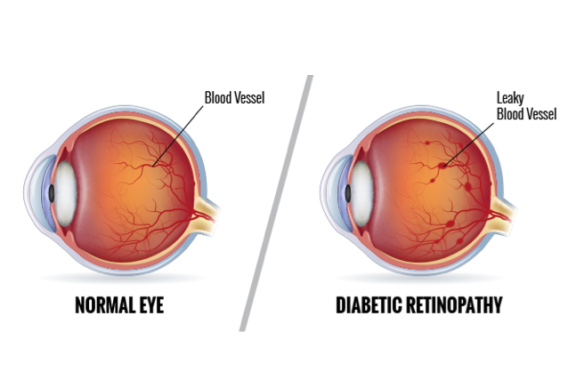All you need to know about Diabetic Retinopathy
What is Diabetic Retinopathy?
Diabetic retinopathy is a condition caused due to the damage of blood vessels and retina within the eye in diabetic people. Uncontrolled or high blood sugar levels in these patients damages the retina and results in the swelling and leakage of blood vessels.
In some cases, the blood vessels can close & limit the flow of blood into the retina. Further, abnormal new blood vessels can grow & bleed or form scar tissue. These changes can result in vision loss.
Stages of Diabetic Eye Disease
Diabetic Eye Disease is of two main stages. The early stage is called as Non-Proliferative Diabetic Retinopathy, or NPDR
In this early stage, changes are witnessed in the retina by an ophthalmologist. Patients usually don't experience any symptoms in this stage.

PDR (proliferative diabetic retinopathy)
PDR is the advanced and severe stage of diabetic eye disease and occurs when, blood flow is stopped and retina starts growing new blood vessels. This condition is called neovascularization. These delicate new vessels often bleed into vitreous. If the bleeding is less, then you may see few dark floaters, if the bleeding to heavy, it may block the vision completely.
The newly grown blood vessels form scar tissue, which cause problems with macula or may result in a detached retina. Without much ado, consult our Challa Eye Care Centre retina specialists for timely treatment, as PDR is a severe condition adversely affectining vision.
Diabetic Retinopathy Symptoms
Below are the some of the symptoms of Diabetic Retinopathy
- Dark spots or floaters
- Fluctuating vision
- Difficulty seeing at night
- Blurred vision
- A loss of vision
- Decreased clarity of colors
How diabetic retinopathy is diagnosed?
Our retina specialists at Challa Eye Care Centre diagnose diabetic retinopathy using special lenses & bright lights to look into the eyes. In some cases, special blood flow pictures are used to evaluate the damage from diabetes to retina. Further, fluorescein angiography test is performed by injecting the dye into a vein, usually in your arm or hand. This dye passes across the blood vessels and a special camera images blood vessels in eye. These captured pictures are used to assess below conditions.
- Abnormal blood vessels
- Leaking of the blood vessels
- Blocked blood vessels
Even, Optical coherence tomography (OCT) is performed to look closely at the retina to detect swelling in the retina
How diabetic retinopathy is treated?
Medical control: Controlling blood sugar & blood pressure levels to minimize the risk of vision loss.
Laser Procedure. This helps in stopping leaking of blood vessels which otherwise can result in swelling of retina. This procedure also can be used to shrink blood vessels & prevent their further growth.
Intravitreal Injections
Special medications are injected into eye to shrink abnormal blood vessels.
Vitrectomy Surgery
For advanced PDR with scar tissue, bleeding, or retinal detachment, our retina specialists recommends surgery known as vitrectomy & retinal detachment surgery. During this surgery, vitreous gel together with any blood is removed the from eye. Also, scar tissue is removed and retinal detachment repaired.
How to prevent Vision Loss from Diabetic Retinopathy
If an individual is a diabetic patient he or she must consult primary care doctor to control blood sugar & blood pressure levels.
Have a regular dilated eye exams. Diabetic retinopathy may even present without any vision problems & the initial symptoms only occur in the advanced stages of disease.
If you experience any vision changes, get in touch with our ophthalmologists right away. Early detection and treatment is the best possible way to prevent vision loss.